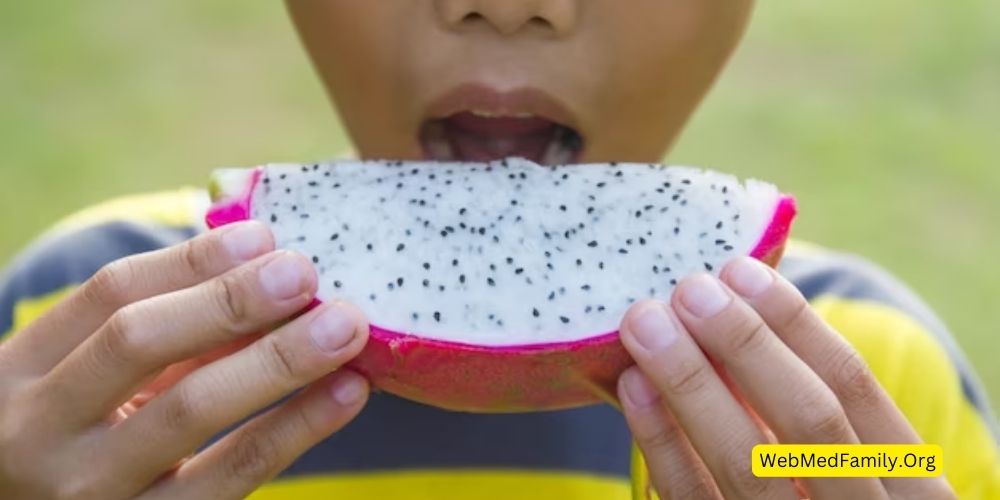Yes, you can eat dragon fruit skin raw. However, it is important to wash it thoroughly before consuming it to remove traces of pesticides and residues. The skin is also rich in fiber and nutrients, making it a valuable part of the fruit.
The skin of dragon fruit is covered in small bristles that can be irritating to the skin, so it is important to handle it with care.
However, it is important to consider personal preference as not everyone may enjoy the taste and texture of the skin.
Other resources do not recommend you eat the skin raw due to its tough texture, mildly bitter taste, and potential pesticide residues.
This is why it is better to peel the fruit before eating to fully enjoy its delightful flavor and minimize the risk of ingesting harmful substances.
Let’s dig more here…
Understanding Dragon Fruit
Dragon fruit is native to Central and South America, but it is now grown in other parts of the world, including Southeast Asia.
Origins
The origins of dragon fruit can be traced back to Mexico and Central America. It is believed that the fruit was introduced to Southeast Asia by French missionaries in the late 19th century. Today, the leading producers of dragon fruit are Vietnam, Thailand, and Malaysia.
Varieties
There are three main varieties of dragon fruit: red-skinned with white flesh, red-skinned with red flesh, and yellow-skinned with white flesh. The red-skinned varieties are the most common, and they have a slightly sweeter taste compared to the yellow-skinned variety. The flesh of the fruit is dotted with small black seeds that are edible.
Dragon fruit is a good source of fiber, vitamin C, and antioxidants. It is also low in calories, making it a healthy snack option. The fruit can be eaten raw, and it is often used in smoothies, salads, and desserts.
Can You Eat Dragon Fruit Skin Raw?
One question that often arises is whether or not you can eat the skin of a dragon fruit raw.
The answer is yes, when eating the skin raw, it is important to note that it can be quite tough and leathery. Some people find the texture unpleasant, while others enjoy the added crunch. If you find the skin too tough, you can try cooking it in a stir-fry or sauté to soften it up.
In addition to being edible, dragon fruit skin is also packed with nutrients. It contains high levels of antioxidants, which can help protect the body against free radicals and reduce the risk of chronic diseases. It is also a good source of fiber, which can help promote digestive health and regulate blood sugar levels.
Health Benefits and Risks
Dragon fruit is a low-calorie tropical fruit that is known for its vibrant red or yellow skin and white flesh dotted with tiny black seeds. The fruit is packed with nutrients and antioxidants that offer several health benefits. However, it is also important to note that the fruit may pose some risks if consumed in excess or if you have certain medical conditions.
Nutritional Value
Dragon fruit is an excellent source of several essential nutrients, including vitamins C and B6, iron, calcium, and magnesium. It is also rich in antioxidants, which help protect your body against free radicals that can damage cells and lead to chronic diseases.
One cup of dragon fruit (227 grams) contains the following nutrients:
| Nutrient | Amount |
|---|---|
| Calories | 136 |
| Protein | 3 grams |
| Fat | 0 grams |
| Carbohydrates | 29 grams |
| Fiber | 7 grams |
| Vitamin C | 9 mg |
| Calcium | 8.8 mg |
| Iron | 0.65 mg |
| Magnesium | 85 mg |
| Potassium | 364 mg |
Read more: What Are the Benefits of Dragon Fruit?
Possible Risks
While dragon fruit is generally considered safe for most people, it may pose some risks if consumed in excess or if you have certain medical conditions. Some possible risks include:
- Allergic reactions: Dragon fruit may cause allergic reactions in some people, especially those who are allergic to kiwi, pineapple, or latex.
- Digestive issues: Eating too much dragon fruit may cause digestive issues such as bloating, gas, and diarrhea, especially if you are not used to eating high-fiber foods.
- Interference with medication: Dragon fruit may interfere with certain medications, including blood thinners and diabetes medications. If you are taking any medication, it is important to talk to your doctor before adding dragon fruit to your diet.
How to Properly Eat a Dragon Fruit
Dragon fruit is a tropical fruit that is native to Central and South America. It is known for its unique appearance and sweet taste. Many people wonder if it is safe to eat the skin of the dragon fruit. The answer is yes, you can eat the skin raw. However, it is important to know how to properly prepare and serve the fruit to get the most out of its flavor and nutritional benefits.
Preparation Methods
Before you eat dragon fruit, it is important to properly prepare it. Here are some steps to follow:
- Wash the fruit under running water to remove any dirt or debris.
- Cut off the stem and slice the fruit in half lengthwise.
- Use a spoon to scoop out the flesh of the fruit from the skin.
- Cut the flesh into bite-sized pieces.
Serving Suggestions
Dragon fruit can be eaten on its own or added to a variety of dishes. Here are some serving suggestions:
- Add diced dragon fruit to a fruit salad for a colorful and nutritious addition.
- Blend dragon fruit with other fruits and yogurt for a refreshing smoothie.
- Use dragon fruit as a topping for oatmeal or yogurt bowls.
- Grill slices of dragon fruit and serve as a side dish to grilled meats.
Dragon fruit is a versatile fruit that can be enjoyed in many different ways. By properly preparing and serving the fruit, you can get the most out of its flavor and nutritional benefits.
Conclusion
In conclusion, dragon fruit skin can be eaten raw, but it is recommended to wash it thoroughly to remove any traces of pesticide. The skin is rather leathery when raw, so some people prefer to cook it in a veggie sauté. However, the skin is rich in fiber and nutrients, making it a valuable part of the fruit.
It is important to note that not everyone may enjoy the taste and texture of dragon fruit skin. Some people find it too bitter or tough to eat. If you are unsure about trying the skin, it is always best to start with a small amount and see how your body reacts.
Frequently Asked Questions
What happens when you eat the skin of dragon fruit?

When you eat the skin of dragon fruit, you consume a significant amount of dietary fiber, antioxidants, and various beneficial compounds. Dragon fruit skin is edible and provides a slightly crunchy texture. However, some individuals find the skin less palatable due to its texture and taste, so personal preference may vary.
Are you supposed to eat the skin of a dragon fruit?

While the skin of a dragon fruit is edible, it is not necessary to eat it. The choice to consume the skin depends on personal preference and culinary preferences. Some people enjoy the added texture and nutritional benefits it offers, while others prefer to peel the fruit and consume only the flesh.
What are the benefits of dragon fruit skin?

Dragon fruit skin offers several benefits. It is rich in dietary fiber, which aids in digestion and helps maintain healthy bowel movements. The skin also contains antioxidants such as betacyanin, which have been associated with potential anti-inflammatory and anticancer properties. Additionally, dragon fruit skin is a good source of vitamin C and other essential nutrients, contributing to overall health and immune function.
How to cook dragon fruit skin?

Cooking dragon fruit skin is not a common practice, as it is typically consumed raw. However, if you wish to experiment with cooking the skin, there are a few methods you can try. One approach is to sauté thin slices of the skin in a bit of oil until they become slightly tender. Another option is to blend the skin into a smoothie or use it as an ingredient in desserts. It’s important to note that cooking the skin may alter its texture and taste, so it is recommended to taste-test and experiment with different recipes to find a cooking method that suits your preferences.
Is dragon fruit skin poisonous?

Dragon fruit skin is not poisonous. In fact, it is safe for consumption and offers several nutritional benefits. However, as with any fruit, it is essential to wash the skin thoroughly before eating to remove any potential contaminants or residues. Additionally, individuals with allergies or sensitivities to certain fruits should exercise caution and consult with a healthcare professional if they have any concerns about consuming dragon fruit or its skin.


